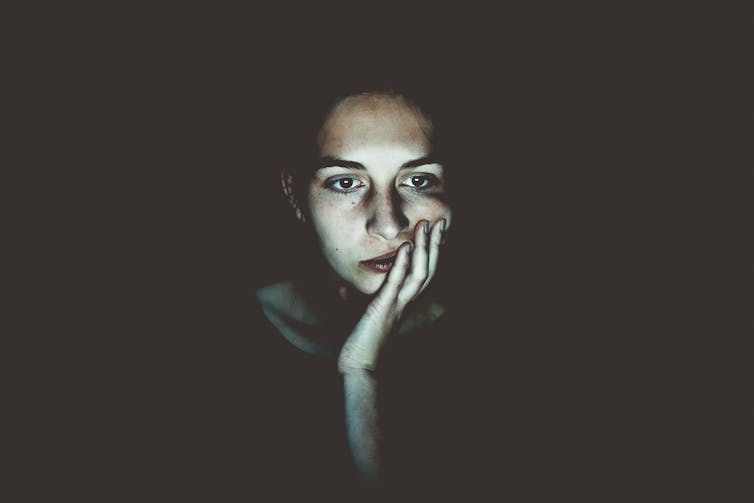Porn use is up, thanks to the pandemic
Online pornography is one business that's booming during the coronavirus pandemic. A psychology researcher explains its pull and whether there are likely to be longer-term effects of this surge in use.

Across the globe, the coronavirus pandemic is affecting almost all aspects of daily life. Travel is down; jobless claims are up; and small businesses are struggling.
But not all businesses are experiencing a downturn. The world’s largest pornography website, Pornhub, has reported large increases in traffic – for instance, seeing an 18% jump over normal numbers after making its premium content free for 30 days for people who agree to stay home and wash their hands frequently. In many regions, these spikes in use have occurred immediately after social distancing measures have been implemented.
Why are people viewing more pornography? I’m a professor of clinical psychology who researches pornography use. Based on a decade of work in this area, I have some ideas about this surge in online pornography’s popularity and how it might affect users in the long run.
What’s the point of pornography?
People use pornography for a variety of reasons, but the most common reason is quite obvious: pleasure.
In 2019, my colleagues and I published a review of over 130 scientific studies of pornography use and motivation. We found that the most common reason people report for why they view pornography is sexual arousal. Research is abundantly clear that the majority of time that pornography is used, it is used as a part of masturbation.
Knowing that people use pornography to masturbate doesn’t explain a great deal about why they might be using more pornography now.
My colleagues and I found that there are several additional reasons people might use pornography. For example, greater levels of psychological distress often predict higher levels of pornography use. People feeling lonely or depressed often report greater desire to seek out pornography; many people report using pornography to cope with feelings of stress, anxiety or negative emotions.
In short, people often turn to pornography when they are feeling bad, because pornography (and masturbation) likely offer a temporary relief from those feelings.

Psychology researchers also know that people use porn more when they are bored. I suspect this relationship between pornography use and boredom is quite likely one of those exponential functions that’s been in the news so much in recent weeks. It’s not just that more boredom predicts greater pornography use – extreme boredom predicts even higher levels of use. The more bored someone is, the more likely they are to report wanting to view pornography.
Is more pornography now a problem later?
The spread of the coronavirus and social distancing measures meant to help contain it have led to increases in social isolation, loneliness and stress – so increases in pornography use make sense.
But are there likely to be negative effects down the road?
Already, numerous anti-pornography activists have expressed grave concerns about these increases in use, with many groups providing resources for fighting those rises.
As a scientist, however, I’m skeptical of blanket claims that increased use right now will translate to widespread negative outcomes such as addiction or sexual dysfunction. Like most aspects of the ongoing coronavirus crisis, there are probably not enough data yet for researchers to make definitive predictions, but past studies do provide some ideas.
Generally speaking, most consumers do not report any problems in their lives as a result of pornography use. Among people who use pornography frequently – even every day – a large percentage report no problems from that use.
Some research, though, does find links between pornography use and potentially concerning outcomes. For example, for men, pornography use is often linked with lower levels of sexual satisfaction, but the current evidence doesn’t untangle whether men use pornography more when they are dealing with sexual dissatisfaction or if men using pornography more leads to more sexual dissatisfaction.
For women, the results are even more unclear. Some studies have actually found that pornography use is associated with more sexual satisfaction, whereas others have found that it is not associated with sexual satisfaction at all.
Studies related to pornography use and mental health have found that hours spent using pornography do not necessarily cause depression, anxiety, stress or anger over time. The same holds for sexual dysfunctions. Although there are cases of people who state that pornography led them to experience erectile dysfunction, large-scale studies have repeatedly found that mere pornography use does not predict erectile dysfunction over time.

A distraction at a boring, anxious time
There is certainly evidence that some people who use pornography also report having mental health concerns or sexual problems in their lives; so far, though, the evidence linking pornography to those things does not appear to be causal.
In short, porn does not seem to be causing widespread problems, and it is probably offering people a distraction from the boredom and stress of current events.
Despite the fact that, prior to COVID-19, 17 states introduced or passed legislation calling pornography use a public health crisis, public health professionals have argued that it really is not one, and I tend to agree. COVID-19, on the other hand, certainly is a public health crisis.
Although humanity has survived countless pandemics over the ages, the current one is the first to occur in the digital age. As disruptive as the coronavirus has been, for many people, opportunities for entertainment and distraction remain greater than they have been at any other point in history.
When social distancing measures are lifted and people are once again permitted to safely spend time with friends, strangers and potential sexual partners, I would expect that pornography use will return to pre-COVID-19 levels. For most users, pornography is probably just another distraction – one that might actually help “flatten the curve” by keeping people safely occupied and socially distanced. Combined with the fact that many people are isolating alone, pornography may provide a low-risk sexual outlet that does not cause people to risk their own safety or the safety of others.
[You’re smart and curious about the world. So are The Conversation’s authors and editors. You can get our highlights each weekend.]
Joshua B. Grubbs does not work for, consult, own shares in or receive funding from any company or organisation that would benefit from this article, and has disclosed no relevant affiliations beyond their academic appointment.
Read These Next
Best way for employers to support employees with chronic mental illness is by offering flexibility
Employers that don’t support employees with mental illness risk missing out on the talents and skills…
Whether Netflix or Paramount buys Warner Bros., entertainment oligopolies are back – bigger and mor
Hollywood has seen this movie before.
Black-market oil buyers will push Venezuela for bigger discounts following US seizure – starving Mad
Venezuela relies on the black-market oil trade for a large chunk of its revenue. US enforcement actions…





